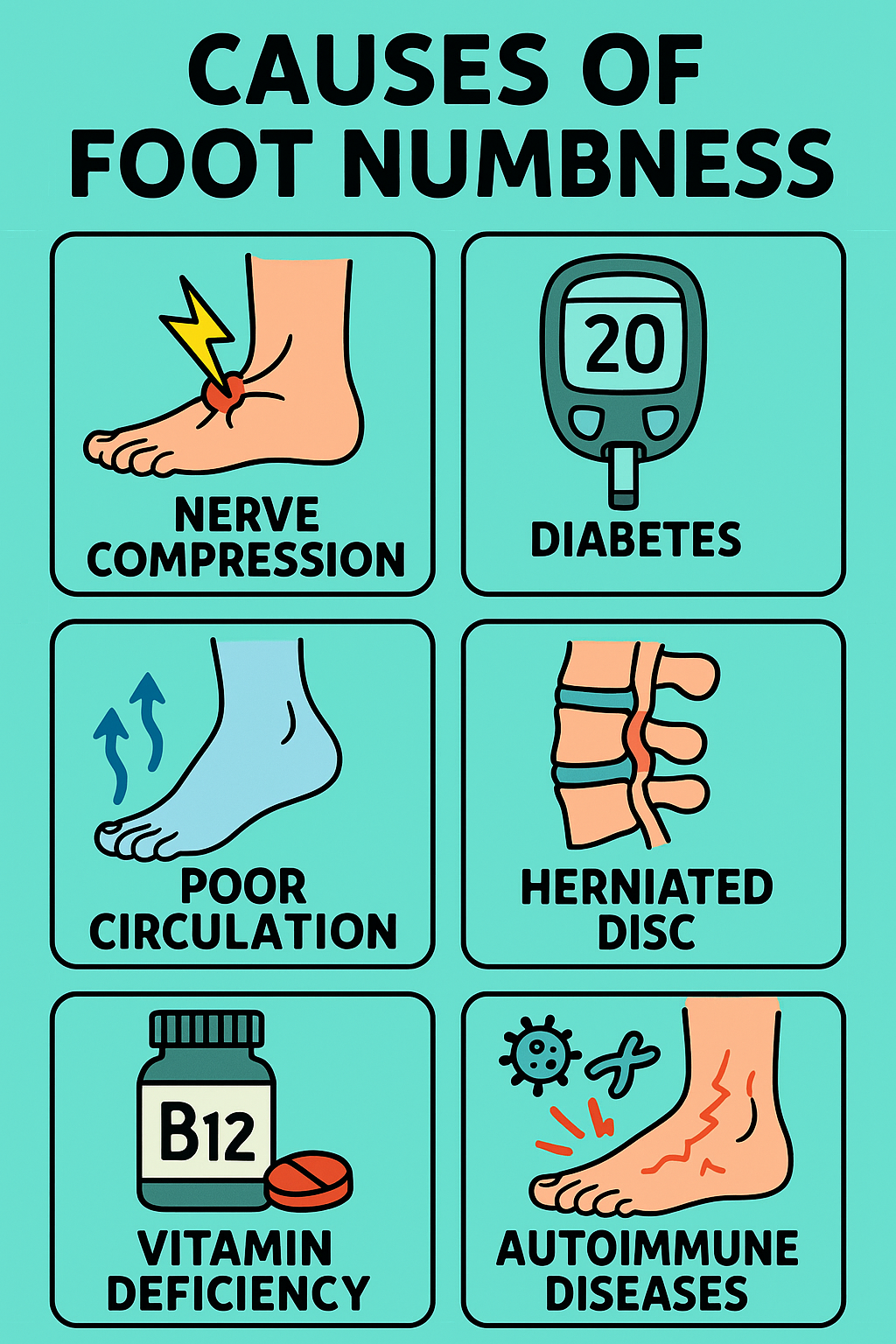Foot numbness—ever experienced it? You’re walking, sitting, or maybe even lying down, and suddenly your foot feels tingly, “asleep,” or just not quite right. It’s a common sensation, and for most people, it’s only temporary. But what if it happens more often, or lasts longer than it should? Let’s take a closer look at foot numbness: why it happens, what causes it, and what you can do about it.
What is Foot Numbness?
Foot numbness is a partial or complete loss of sensation in the foot. It often feels like tingling, pins and needles, or a “dead” sensation. Everyone’s had their foot “fall asleep” at some point, but ongoing numbness could point to something more.
How common is it? In the general population, about 7-10% of adults will experience some form of persistent numbness or tingling in their feet during their lifetime. It’s especially frequent in people over 50 and those with certain health conditions.
How Does It Happen?
Picture your nerves as a network of electrical wires. They carry messages from your brain and spinal cord to every inch of your body—including your toes. When something interrupts these signals, you get numbness.
It’s a bit like watering your garden with a hose: if you step on the hose, water can’t get through. With your body, pressure, injury, or disease can “step on” your nerves, slowing down or blocking the signals. Sometimes, blood flow issues do the same thing—no oxygen, no messages!
What Causes Foot Numbness?
Many things can cause foot numbness. Here’s a quick intro:
Foot numbness can result from temporary nerve compression, chronic diseases, injuries, or even poor circulation. Some causes are minor and go away quickly, while others require medical attention.
Let’s break down the main causes:
- Nerve Compression (Peripheral Neuropathy): The most common cause. This is seen in about 30% of cases. Nerves can get pinched by swelling, tight shoes, or sitting awkwardly.
- Diabetes: High blood sugar damages nerves over time. Roughly 25-30% of people with diabetes develop foot numbness (diabetic neuropathy).
- Poor Circulation: Conditions like peripheral artery disease (PAD) limit blood flow. This accounts for about 15% of cases.
- Injury: Sprains, fractures, or herniated discs in the back can all affect nerve signals to the foot (about 10%).
- Vitamin Deficiencies: Lack of B vitamins, especially B12, can lead to numbness (around 5%).
- Other Causes: Autoimmune diseases (like multiple sclerosis), alcohol abuse, infections, or even certain medications can be to blame (about 10-15%).

Risk Factors
Who’s most at risk for foot numbness? Well, it’s not just older adults.
Anyone can experience it, but some groups are more vulnerable—especially those with health conditions or lifestyles that affect nerves and blood flow.
Here are the top risk factors:
- Diabetes
- High blood pressure
- High cholesterol
- Obesity
- Smoking
- Heavy alcohol use
- Sedentary lifestyle
- Repetitive stress (standing or sitting too long)
- Certain medications (like chemotherapy drugs)
- Vitamin deficiencies (especially B12, folate, and E)
Did you see yourself in any of those? If yes, you’re not alone!
Other Symptoms
Foot numbness rarely travels alone. Depending on the cause, you might notice:
Common symptoms:
- Tingling or “pins and needles”
- Burning sensation
- Weakness in the foot or ankle
- Trouble walking or balancing
- Cold or pale skin (if circulation is involved)
When things get worse:
If the cause is serious or left untreated, numbness can progress. You might notice:
- Loss of muscle control
- Severe weakness
- Foot ulcers (especially in diabetes)
- Complete numbness (can’t feel pain, heat, or cold—risking injury)
If numbness comes with severe pain, sudden weakness, or problems with bladder/bowel control, seek help immediately—these can be signs of a medical emergency, like a nerve or spinal cord problem.
Tests to Identify the Cause
How do doctors get to the bottom of foot numbness? The “gold standard” diagnostic test is Nerve Conduction Studies and Electromyography (EMG). Here’s what to expect:
- Nerve conduction study: Small electrodes are placed on the skin. They deliver tiny electric pulses to see how well nerves are working.
- EMG: A thin needle is inserted into muscles to check nerve-to-muscle signal strength.
These tests can feel a bit odd but aren’t usually painful. They help pinpoint if your numbness is from a nerve problem, and if so, where.
Other possible tests:
- Blood tests (to check for diabetes, vitamin levels, or thyroid issues)
- MRI or CT scan (to look for back or nerve injuries)
- Doppler ultrasound (to check blood flow)
Treatment for Foot Numbness
Let’s talk about what you can do if you’re dealing with foot numbness.
For most people, treatment depends on the cause:
- Addressing the underlying problem is key. For example, controlling blood sugar in diabetes, improving circulation, or treating a back injury.
- Medications: Pain relievers, anti-seizure drugs (like gabapentin), or antidepressants may help nerve pain.
- Physical therapy: Strengthens muscles, improves balance, and helps retrain nerves.
- Lifestyle changes: Quitting smoking, exercising regularly, and improving diet can all make a difference.
- Proper footwear: Shoes that fit well and support the foot prevent pressure on nerves.
If the gold standard treatment doesn’t work or isn’t possible, doctors may try:
- Vitamin supplements (if a deficiency is found)
- Surgery: Sometimes needed if there’s severe nerve compression or spinal problems.
- Pain management: TENS (transcutaneous electrical nerve stimulation), acupuncture, or other therapies.
Important: Don’t ignore numbness that lasts more than a few days, gets worse, or comes with other worrying symptoms. The earlier the cause is found, the better the chance for recovery.
References
- “Foot Numbness: Causes, Symptoms, and Diagnosis.” Healthline, 2023. https://www.healthline.com/health/foot-numbness
- “Numbness and Tingling in Feet.” Cleveland Clinic, 2022. https://my.clevelandclinic.org/health/symptoms/17565-numbness-and-tingling
- “Peripheral Neuropathy.” Mayo Clinic, 2024. https://www.mayoclinic.org/diseases-conditions/peripheral-neuropathy/symptoms-causes/syc-20352061
